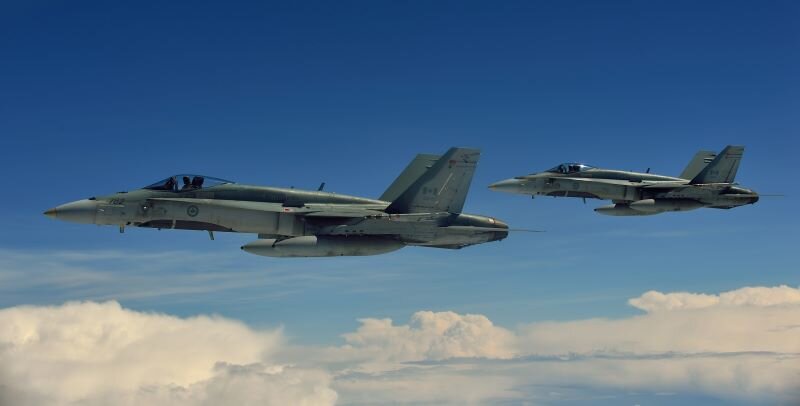Peraton Canada: A defence contractor soars, thanks to its entrepreneurial spirit
HOW IT WORKS
High above the Beaufort Sea, a Royal Canadian Air Force CF-18 monitors the airspace in defence of Canadian sovereignty. Unexpectedly, the onboard radar fails, and the aircraft returns to base. A Department of National Defence technician removes the part and ships it to the Calgary headquarters of Peraton Canada, which performs approximately 3500 procedures, including micro-miniature repair and secure Electronic Warfare repair, every year on Canada’s fighter fleet (over 55,000 repairs to date). Peraton performs maintenance, engineering, and supply chain management services for Canada’s CF-18 avionics suite and associated support equipment.
Peraton’s 76,000-square-foot headquarters has recently undergone a state-of-the-art renovation, a kind of engineering dream office with state-of-the-art training facilities and a design/development lab. It also houses a unique sustainment model that, in the company’s words, “optimizes program performance across air, land, or sea. . . [and] heralds the next generation of cooperative military advancement.”
The logistics and engineering teams work closely together in ensuring the reliability and availability of electronic systems on the aircraft. If an item fails, it’s good to return it, repair it, and send back. But it’s much better if it doesn’t fail in the first place,” says Jim Gillespie, Vice President, Canada. Peraton tracks the logistics behind every system in the aircraft, seeking to extend the amount of time that an instrument works optimally aboard an aircraft. The engineering team is tasked with finding solutions to the issues that the logistics team identifies. These are meaningful interventions, as Peraton is working with the largest allocation of government-owned materiel in Canada, over $870M.
Jim Gillespie, Vice President, Canada. Peraton
THE 125-YEAR-OLD STARTUP
Peraton Canada is an affiliate of Peraton, the name under which, as of 2017, the former Harris Corporation Government Services became known. Peraton (global) employs 3,600 people in markets including Space, Cyber, Intelligence, Defense, Communications and Homeland Security, and has annual revenues of US$1.1 B. The company refers to itself as “a new disruptor in the national security industry,” but its corporate roots stretch back to the late 19th century. The company’s Calgary facility first opened for business in 1999 and is Canada’s only prime contractor for avionics support on a fighter platform.
Today, Peraton is a fresh name in the industry with an established portfolio. Working differently than their peers – with agility, the freedom to innovate, an entrepreneurial spirit and a culture of responsibility. Peraton focuses on building a community that is diverse, collaborative and recognizes the need to have the right teams and talent in place.
Peraton Canada currently employs approximately 100 people, most of whom are in its Calgary headquarters. “The headcount hovered at around 50 for the longest time,” says Gillespie, “but the staff put a lot of focus into building capabilities internally, and we went out and chased other defence contracts. We’ve grown to over 100 in just the last five years. That’s the entrepreneurial spirit that sets this defence contractor apart. We’re a little different from many defence companies.”
WORKING WITH SMALL BUSINESS
Peraton Calgary currently has approximately 300 suppliers in its database and has helped launch a number of significant success stories. VariSystems, for example, a Calgary-based manufacturer of ruggedized cables to the seismic energy industry, cold-called one day. They saw an opportunity to sell their product within the defence industry and were looking for some help making contacts. “We sponsored their controlled goods registration, and gave them some small projects,” says Gillespie. “Within two years, they had split into two divisions: one oil and gas, one defence. Eventually, they wound up winning so many defence contracts that one of their competitors, Teledyne (UK) bought them.”
WESTERN CANADIAN DEFERENCE INDUSTRIES ASSOCIATION
Peraton is an active member of The Western Canadian Defence Industries Association (WCDIA), which promotes the aerospace, defence and security industry in British Columbia, Alberta, Saskatchewan and Manitoba. WCDIA also runs a series of networking events across the West, for sharing best practices, showcasing capabilities, and providing education and quality networking. A cornerstone of WCDIA’s networking events is the two-day “Getting in the Game” bootcamp session, which runs several times a year and helps small-and-medium-sized businesses negotiate the process of becoming a supplier to the defence industry. Gillespie gave a presentation on procurement in defence and, as in an episode of “Dragons Den,” participants make a pitch and receive a critique from an expert panel. They return the next day and pitch again. The panel members act as mentors beyond the confines of the bootcamp itself; Gillespie estimates that he has mentored about 25 a year.
One of those pitches was put together by Calgary companies AERIUM Analytics (geospatial intelligence and big data analytics) and Canadian UAVs (military-grade unmanned aviation services). It has turned out to be one of the most exciting and impactful initiatives currently in development in the province.
SKYSENSUS
So promising was that pitch that only eight months passed until Peraton signed contracts with AERIUM and Canadian UAVs—and with Foremost UAS Test Range —to fund Project SkySensus. SkySensus is a five-year, multi-million-dollar research and development/commercialization project centered on the routine use of Beyond Visual Line of Sight (BVLOS). “We went from these two people to signing contracts, to more than 40 high-quality, permanent, five-year positions for people working on this marketable project that has nowhere to go but up,” says Gillespie.
Peraton is expanding into the unmanned market in a way that’s a bit different. In Alberta, there are more than 200 companies that specialize in unmanned systems, but most of them are small and specialized. Peraton's approach is to provide an end-to-end solution that moves far beyond merely building and selling drones.
In fact, Peraton is performing the research and development required to operate in a Beyond Visual Line of Sight (BVLOS) environment, as well as writing policy and procedure for Transport Canada. They’re also establishing training programs and support services for UAV operators.
“UAVs are not dissimilar to aircraft—after all, as a UAV flies, it must detect and avoid other traffic, and operate safely,” says Gillespie. “Think about it: if a drone encounters an obstacle and falls out of the sky over a crowd, people on the ground will be in serious jeopardy. Canadian UAVs is building the avoid and detect capability; AERIUM is doing analytics that tells you whether it’s safe to fly or not; the range is doing flight operations.”
“We’re a little different from many defence companies. We’re entrepreneurial. We support and grow small business—and we don’t just talk about it, we do it.”
BEYOND VISUAL LINE OF SIGHT
BVLOS is key to advancing commercial and defence applications of unmanned aircraft systems (UAS) technology. Simply put, it signifies the ability to operate an unmanned aerial vehicle (UAV) at a distance at which it cannot be seen by its operator; this enables the drone to cover much greater distances, collect more data per flight, make critical deliveries, or perform inspection of infrastructure, among many other uses. The technology has several important use scenarios:
Protecting Canadian sovereign airspace. Part of Canada’s NORAD role is to monitor incursions into North American airspace. Sending fighter aircraft is effective, but extremely expensive. With BVLOS, we can start surveilling the north efficiently and effectively.
Agriculture: BVLOS technology can enable the precise monitoring of crop growth and seeding. To reduce input and costs of fertilizer, farmers can use BVLOS to control where the seed drill is going, making efficient use of all available land.
Emergencies. BVLOS can reduce risk to first responders and victims of fires, floods, and other disasters. Precise measurement of fire margins and their changes will help inform evacuation responses.
Oil and gas: Right now, oil and gas pipelines are monitored via truck, with crews that drive back and forth the length of the line looking for leaks and other problems. It’s an imprecise, time-heavy and wasteful solution. BVLOS drone surveillance, on the other hand, will use sensors to detect pressure loss and leaks and provide visual updates within 75-100 feet of the ground.
THE FOREMOST RANGE
Foremost, the first BVLOS testing range for drones in Canada, was established in 2008. It provides UAV operations with permanent restricted airspace to 18,000 feet (5,400 metres) above sea level over 2,400 square kilometres of farming country in the south eastern corner of Alberta. It is one of only two airspaces certified by Transport Canada for BVLOS operations. The range was established with the intention of providing crucial test space for companies hoping to commercialize new UAV technologies and is one of the best such facilities in North America.
UNIVERSITY OF CALGARY AEROSPACE NETWORK
Peraton is a Supporting Organization of The University of Calgary Aerospace Network (UCAN), a team of more than 40 professors across the faculties of Science, Engineering, Arts and Business. Students and professors collaborate with national and international academic institutions, industrial partners and governmental agencies—including NASA, the Canadian Space Agency (CSA), and major defence contractors (such as Peraton)—as well as with small and medium businesses and startups. UCAN’s areas of research include Multi-Sensing & Avionics, Flight Dynamics & Control, Navigation & Positioning, Robotics & UAV and Space Systems, among others. Peraton is currently in the process of exploring partnership projects with UCAN.
THE SAIT CONNECTION
A significant number of Peraton technicians are Southern Alberta Institute of Technology (SAIT) grads. Peraton hires certified electronics specialists from SAIT, and then spends between six months to two years training them so that they can perform the highly technical work required. In the last two years, Peraton has established a close working relationship with SAIT. Electronics students are hosted at the Peraton site for informational tours and, some of the SAIT students were hired on for the summer. One of those became a full-time employee. Peraton’s electronics repairs manager has recently participated on the school’s review board, reviewing curriculum and revising SAIT training to support the needs of the defence industry.
WHAT’S NEXT
Peraton Canada is poised to take a leadership position in UAV technology, following, in part, in the footsteps of its U.S. parent. The company’s platform-agnostic sustainment model makes it an attractive partner for companies looking to participate in defence related unmanned opportunities that will aim to bolster Canada’s Strong, Secure, Engaged initiatives. Current unmanned opportunities on Peraton’s radar include the Remotely Piloted Aircraft System project, which will see the Canadian Armed Forces attain an armed Medium Altitude Long Endurance (MALE) UAV. From a naval perspective, Peraton aims on leveraging the capabilities and experience attainted through decades of experience with the United States Navy to support industry partners with Canadian bids for systems including, but not limited to, the Remote Minehunting and Disposal System, and The Royal Canadian Navy Intelligence, Surveillance, Target Acquisition And Reconnaissance Unmanned Aircraft System.





